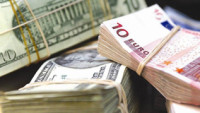 European markets finished the day slightly higher yesterday after Federal Reserve chairman Jerome Powell clarified his comments from the previous day with respect to what the Fed is likely to do on rates in two weeks’ time.
European markets finished the day slightly higher yesterday after Federal Reserve chairman Jerome Powell clarified his comments from the previous day with respect to what the Fed is likely to do on rates in two weeks’ time.
In a manner of a parent soothing an errant child who is throwing a bit of a tantrum Powell merely restated that the Federal Reserve remains data-dependent and that nothing has been decided when it comes to whether we get 25bps or 50bps.
The comments helped briefly pull yields lower and pull the US dollar off its highs for the day, but the reality remains that markets are slowly starting to come to the realisation that rates are likely to remain higher for longer and that the terminal rate is also likely to settle at a much higher level.
Despite this US markets although closing lower on the day have managed to hold up reasonably well, and more importantly in the case of the S&P500 and Nasdaq 100 are still above key technical supports at the 200-day SMA. Even more strange is how well the Nasdaq 100 is holding up relative to the rest of the US market, despite the rise in yields we’ve seen since the January payroll numbers.
The US 2-year yield has risen over 100bps since the Fed last met, pushing well above 5%, while US 6-month T-bills are also yielding well above 5% as well.
This puts tomorrow’s February payrolls front and centre when it comes to where US equity markets could head next.
Yesterday’s ADP payrolls report for February came in better than expected at 242k, while wage growth came in at 7.2%, still well above core inflation, while we only saw a modest decline in January JOLTS vacancies to 10.84m, reinforcing the tight nature of the labour market.
These numbers don’t scream an economy that is likely to see a quick easing of inflationary pressures, a factor that markets don’t appear to be currently pricing in. Its hard to see how the Fed can even contemplate getting close to its inflation target of 2% much before 2025 given the challenges facing the global economy.
As we look ahead to the next couple of days there are two events that could have a big say on how much volatility we see over the next few sessions.
The first one is the Bank of Japan rate decision, a meeting which will be the swansong for Haruhiko Kuroda as the mouthpiece of Japanese monetary policy, to be replaced by Kazuo Ueda as the new Bank of Japan governor.
A lot of the commentary around Ueda has seen him paint a fairly neutral stance when it comes to the prospect of possible policy tweaks. This would suggest that the current policy of yield curve control (YCC) is unlikely to see any changes in the short term. That said, given that this will be Kuroda’s last meeting as central bank Governor there is the possibility he might start to lay the groundwork for a policy change in the coming months.
Japanese inflation is already well above target at 4.3% and looks set to continue rising. It’s hard to envisage a scenario that would see the Bank of Japan happy with an inflation rate that is rising sharply, and a currency that is once again wilting against the onslaught of a strong US dollar.
The main focus for Friday will be the February payrolls report after the January numbers shook the markets out of the complacency that had characterised sentiment as we started 2023 on a strong note.
As noted earlier the market reaction has been most notable in terms of bond yields, and while equity markets have continued to hold onto a narrative that further rate hikes are likely to be limited, the strength of the economic data since then has shifted that perception quite markedly in recent weeks.
In the space of a month, we’ve gone from a narrative that had rate cuts coming before the end of the year, to an imminent pause in the next couple of months, to how many more rate hikes can we now expect?
Tomorrow’s payrolls report could well go further in reinforcing the latter if the jobs growth we saw in January isn’t revised significantly lower and February also sees a strong print.
Just to be clear, no one is expecting another 517k, and we could also see a significant revision but a February number anywhere in the region of 220k would still be in line with a robust US labour market, especially with unemployment at 3.4% and the lowest level since 1969.
Furthermore, the rising participation rate that we saw in January suggests we are seeing people returning to the workforce, The rise to 62.4% matched its highest level since the start of the pandemic.
EUR/USD – has retested the previous lows at 1.0520/30 with the prospect we could see a retest of the 1.0480 area. The 1.0730 area remains a key resistance.
GBP/USD – falling below the 200-day SMA has seen the pound fall to the 1.1800 area, opening up the prospect that we could slide towards 1.1640 on a break below the 1.1800 area. Resistance back at the 1.1980 area.
EUR/GBP – broken through the trend line resistance at 0.8900 from the January peaks and could see a move towards the 0.8980 area. We need to push below support at the 0.8820/30 area to retarget the 0.8780 area.
USD/JPY – continues to push up and over the 200-day SMA, with a concerted break through the 137.30 opening up the 138.20 area, and on to 139.50. Support comes in at the 135.20 area. We also have interim support at 133.60.












